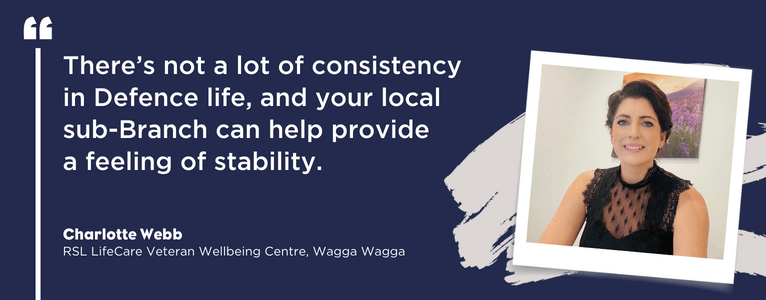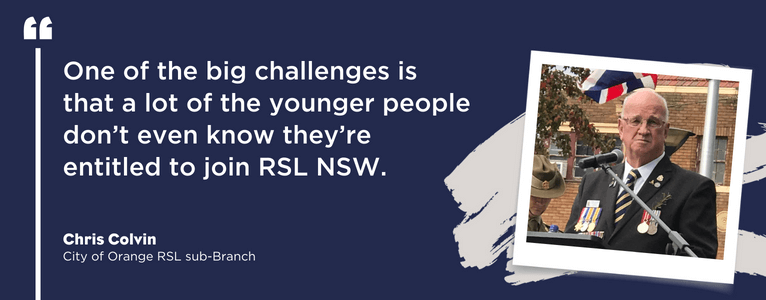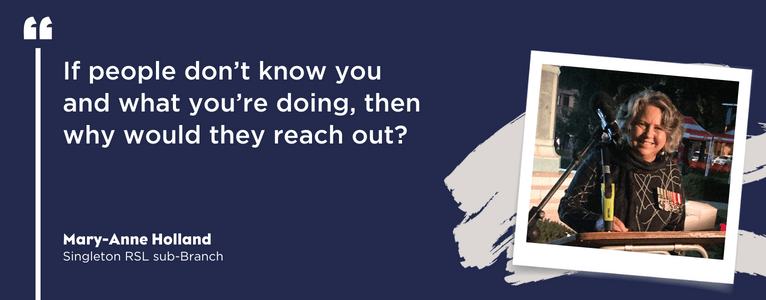These three RSL sub-Branches are engaging current Defence personnel

How Wagga Wagga, City of Orange and Singleton RSL sub-Branches are building community by connecting with serving members.
By Tess Durack
At a glance:
- RSL sub-Branches are nurturing ties with Defence personnel to spread word of RSL NSW’s charitable purpose in support of veterans and their families.
- The Wagga Wagga RSL sub-Branch has fostered a relationship with RAAF Base Wagga and Kapooka Army Base by collaborating on commemorative services and social activities.
- In Orange, President Chris Colvin has made an effort to encourage everyone, regardless of service length or background, to join the organisation.
- “We’ve built trust and rapport [with personnel], which means people feel more comfortable calling me for a quiet conversation,” says Warrant Officer and Singleton RSL sub-Branch President Mary-Anne Holland
Whether you’ve served for one day or one thousand, RSL NSW welcomes veterans of any age to join the organisation – and RSL sub-Branches across the state are engaging veterans currently serving in Defence.
The Wagga Wagga, City of Orange and Singleton RSL sub-Branches are busy nurturing relationships with their communities of serving personnel. Over time, this should see them serve a wider demographic and improve the delivery of support and services to Defence and veteran communities.
Creating space for veterans in Wagga Wagga
Such is the reputation of its legendary sausage sizzle, and the acceptance of the sub-Branch as a fixture at so many of the garrison town’s events, that on the one occasion the Wagga Wagga RSL sub-Branch wasn’t involved in the Kapooka Christmas party, there were cries of “Where are the sub-Branch sausage sandwiches? They’re the best!”
“Fortunately, at the command level, we have a great relationship with the RAAF Base Wagga and Kapooka Army Base,” says Rod Cooper, President of the Wagga Wagga RSL sub-Branch. “They support us with commemoration services, and are very obliging and easy to work with.”
And the support goes both ways. A monthly barbecue put on by the sub-Branch, for example, is a regular opportunity to connect with newer serving personnel.
“The RAAF base and Kapooka bring along their trainees to spend a couple of hours,” says Cooper. “And we do a sausage sizzle each year for the Defence Member and Family Support organisation when they welcome new Defence families posted into the area.”
Last year saw the inaugural Spring Picnic in the Park, which further cemented the sub-Branch’s commitment to including the families of veterans and serving personnel.
“We worked with the Kapooka Community Group, RANCH and RSL LifeCare Veteran Services to welcome more than 170 people to our first picnic in the park with jumping castles, face painting, acrobats, coffee and ice cream,” says Cooper.
The sausage sizzle pops up again at the Kapooka preschool Christmas party, while regular lawn bowls bring together the over-18s.
It’s all part of making the sub-Branch visible in the community and helping veterans, serving personnel and their families to be aware the sub-Branch is there for them.

As to how much of this community presence translates into memberships is, says Cooper, hard to say. Though with a 12.5 per cent increase in membership over 2023, it can’t be hurting.
The challenge is to make membership appeal to a younger generation while still supporting older veterans.
“I’m still connected with all the people I served with in the Navy,” says Cooper. “But do younger people want the same connection, or do they just want to move on? I wish I knew the answer.”
It’s a challenge that Charlotte Webb, Manager of the RSL LifeCare Veteran Wellbeing Centre in Wagga Wagga, is also determined to help meet, and the sub-Branch and Wellbeing Centre often collaborate on events together.
“As a veteran, I understand how important it is to educate serving personnel about what the sub-Branch does and how it can support them,” explains Webb. “I know myself I didn’t have enough information about how I could have been involved earlier on, or that I could have included the kids more.
“We talk a lot with the veterans and serving members we support at the Wellbeing Centre about how helpful belonging to the sub-Branch can be. There’s not a lot of consistency in Defence life, and your local sub-Branch can help provide a feeling of stability.”
Building partnerships in Orange
“One of the big challenges is that a lot of the younger people don’t even know they’re entitled to join RSL NSW,” says Chris Colvin, President of the City of Orange RSL sub-Branch.
“They think they have to have served overseas to be considered a veteran, and that’s just not true. If you’ve been a Reservist, if you’ve worn a uniform for one day, you’re a veteran, and you’re welcome at the sub-Branch. And your family is welcome too – bring your kids, bring your partner.”
One of the most effective ways for the sub-Branch to get this message out has been through forging a relationship with the Commanding Officers and the Regimental Sergeant Majors attached to the 1/19 Royal NSW Regiment based in Orange.
“I first met with them just after COVID, and we decided to work together to raise awareness about the sub-Branch and what it can offer serving personnel now and when they finish their service,” says Colvin.
Jason Jackson, former RSM of the regiment, agrees.
“It’s critical that they know when they leave the service, they can still be part of a community that supports them,” he says.

Important also is the knowledge that a soldier doesn’t need to have ended their service to be able to call on a sub-Branch for support.
“Having regular informal catch-ups with the sub-Branch committee means regiment leadership is aware of what resources are available and can properly refer soldiers who might be in need of those resources,” explains Jackson.
To further strengthen the sub-Branch’s connection with the local regiment, Colvin and his committee created the Perpetual Trophy to be awarded each year to the champion shot of the entire regiment.
“We have enough space for 20 plaques on it, so we’re locked in for at least 20 years!” laughs Colvin.
The trophy is presented at the annual regimental dinner and, Jackson says, is recognised as a significant link between the sub-Branch and the regiment.
“It brings home the message that there’s a partnership between us.”
At 40, John Catterson is one of the youngest members of the City of Orange RSL sub-Branch and feels strongly that building these connections is key to helping veterans and serving members become more aware of what the sub-Branch offers.
As the sub-Branch’s Wellbeing Support Officer, he’s helped establish a fortnightly casual coffee club. “It’s not so much a recruiting tool as an opportunity to build connections with the community of veterans and give serving personnel a chance to check in if they want to.”
While Catterson respects that commemoration remains an essential role for the sub-Branch, he’s keen to see an equal focus on the wellbeing of younger veterans who might benefit from feeling better connected.
“I’m more concerned with looking forward than looking backwards,” he explains.
And doing that means showing serving personnel how sub-Branch membership provides the opportunity to keep contributing and to connect with valuable support services.
Engaging the Singleton community
When Mary-Anne Holland, who is a serving Warrant Officer, became President of the Singleton RSL sub-Branch one year ago, she started by establishing a committee in which each position was held by both an older and a younger veteran or partner of a veteran.
“It means there’s a font of knowledge and governance experience that is passed on to the younger member, who typically has the IT and communications know-how that we need to get our message out,” explains Holland.
Moreover, she points out, it widens the pool of possible members to have representation from different generations.
“If someone brings one new person to an event or committee meeting, that’s one person we didn’t have before.”
This recognition of Singleton as a network of potential connections encourages Holland and her team’s focus on engaging meaningfully with the community at every opportunity.
“You have to know and be involved with your community,” she says. “Meet with all the other service providers and community organisations so you can share ideas, collaborate and cross-pollinate. Share your schedules with other ESOs so you don’t double up on events and can be present at each other’s activities.”

Being so thoroughly integrated with the community also gives the sub-Branch an opportunity to reach serving personnel or veterans who are part of other organisations but haven’t yet connected with their sub-Branch.
“It helps spread the word that your sub-Branch is active and engaged. If people don’t know you and what you’re doing, then why would they reach out?
“We have a strong presence in the community and are always visible at commemorations and other events. We’ve built trust and rapport, which means people feel more comfortable calling me for a quiet conversation or reaching out on behalf of someone else.
“It might take a few months, but eventually they’ll come to an event or a meeting.”
And demonstrating to serving personnel that the sub-Branch is there for them means resources can be accessed or support offered before a crisis arises.
Secretary Trevor Stewart recalls years when younger veterans didn’t want to march on ANZAC Day because they were alienated from a sub-Branch they felt didn’t value their service equally to that of the older veterans.
“Inviting younger veterans to be involved, lay a wreath or take part in a ceremony honouring their service was crucial to connecting with them and building trust,” says Stewart.
“The tradition is still really important. So it’s not about changing our values, it’s about changing and modernising how we deliver on them.”






